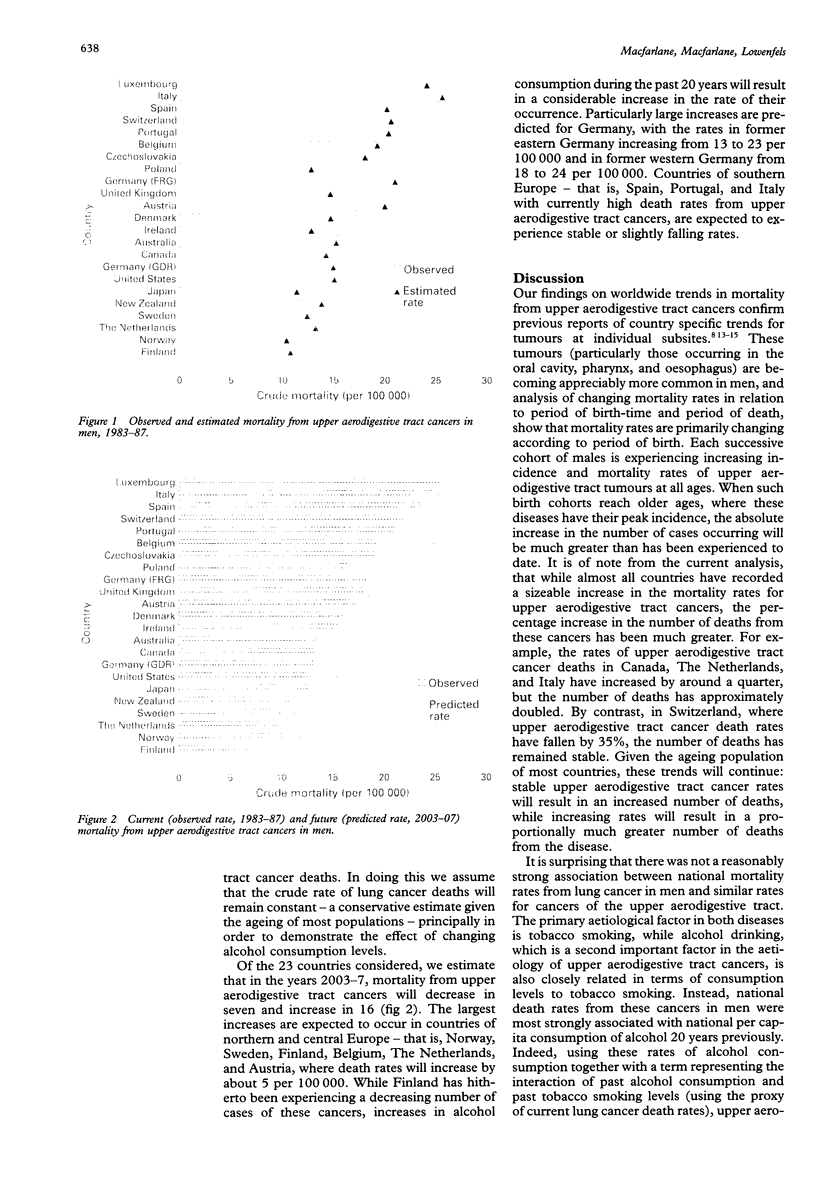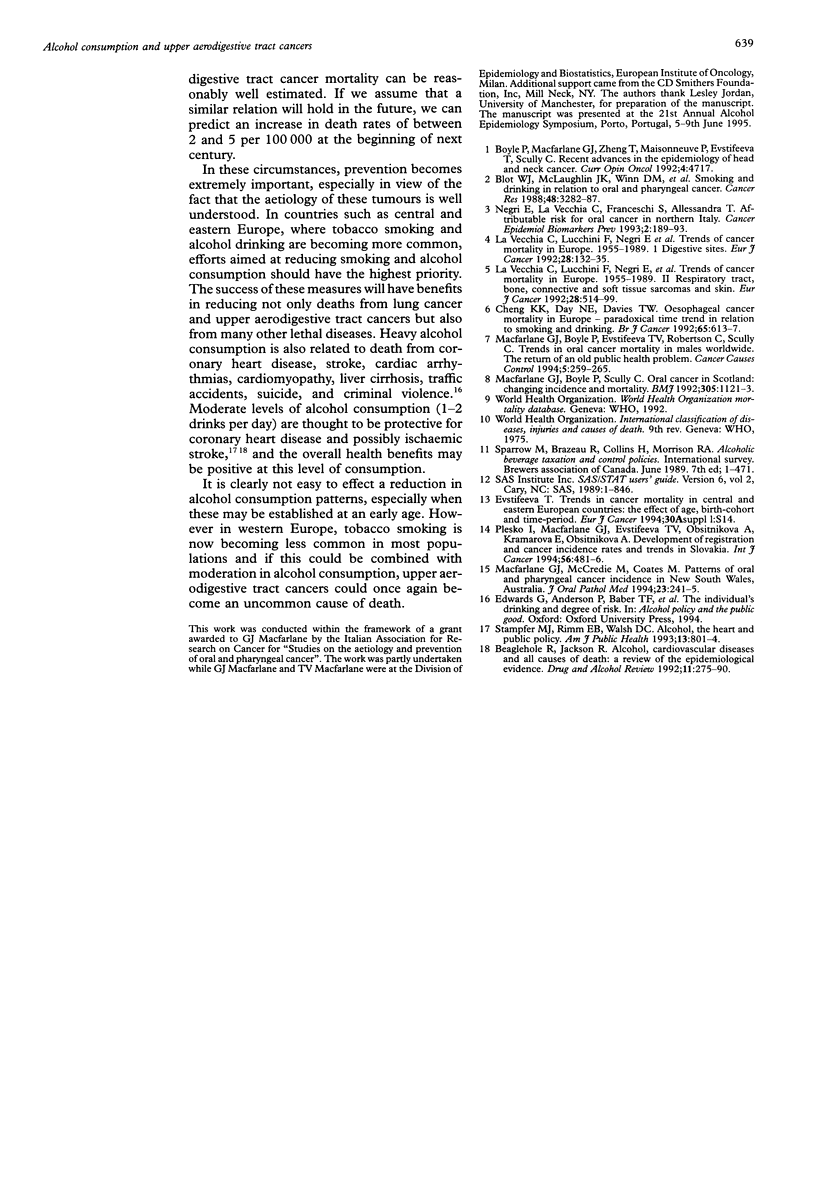Abstract
STUDY OBJECTIVES: To assess current trends in male mortality from cancers of the oral cavity/pharynx, oesophagus, and larynx (upper aerodigestive tract cancers), and relate these to past national consumption of alcohol and smoking of cigarettes. To assess the impact of current trends in alcohol consumption and tobacco smoking on likely future rates of these cancers. DESIGN: Mortality data for cancers of the oral cavity/pharynx, oesophagus, and larynx were obtained for the years 1955-89 in 25 countries located in North America, Australasia, Europe, and Japan. Information on past and current alcohol consumption was also obtained for these countries, while current national lung cancer rates were used as a proxy measure of past smoking levels. SETTING: The World Health Organization mortality database. MAIN RESULTS: National death rates from cancers of the oral cavity/pharynx, oesophagus, and larynx (considered together) are currently increasing among men and are most strongly associated with the level of per capita consumption of alcohol 20 years previously. They were less strongly associated with the level of alcohol consumption 10 years ago, and only very weakly associated with the current level of lung cancer mortality (a marker of past smoking habits). Regression analysis showed that the national rate of upper aerodigestive tract cancer could be estimated using information on past alcohol consumption and an interaction term between alcohol consumption and current lung cancer rates. Assuming stability in rates of lung cancer, the sizeable increase in alcohol consumption from 5 to 10 litres per capita each year that occurred in some countries during the 1960s and 70s means that increases of around 5 per 100,000 in the death rate from these cancers can be expected in these countries in the next decades. CONCLUSIONS: Previous alcohol consumption in a country is a strong predictor of deaths from cancers of the upper aerodigestive tract in men, and current increases in death rates can probably be related to increases in consumption which took place during the 1960s and 70s. Combined with a reduction in tobacco smoking, which is already taking place in some countries, reversing the trend of increases in consumption of alcohol has the potential for a sizeable impact on the burden of these cancers.
Full text
PDF



Images in this article
Selected References
These references are in PubMed. This may not be the complete list of references from this article.
- Beaglehole R., Jackson R. Alcohol, cardiovascular diseases and all causes of death: a review of the epidemiological evidence. Drug Alcohol Rev. 1992;11(3):275–289. doi: 10.1080/09595239200185811. [DOI] [PubMed] [Google Scholar]
- Blot W. J., McLaughlin J. K., Winn D. M., Austin D. F., Greenberg R. S., Preston-Martin S., Bernstein L., Schoenberg J. B., Stemhagen A., Fraumeni J. F., Jr Smoking and drinking in relation to oral and pharyngeal cancer. Cancer Res. 1988 Jun 1;48(11):3282–3287. [PubMed] [Google Scholar]
- Cheng K. K., Day N. E., Davies T. W. Oesophageal cancer mortality in Europe: paradoxical time trend in relation to smoking and drinking. Br J Cancer. 1992 Apr;65(4):613–617. doi: 10.1038/bjc.1992.124. [DOI] [PMC free article] [PubMed] [Google Scholar]
- La Vecchia C., Lucchini F., Negri E., Boyle P., Maisonneuve P., Levi F. Trends of cancer mortality in Europe, 1955-1989: I, Digestive sites. Eur J Cancer. 1992;28(1):132–235. doi: 10.1016/0959-8049(92)90402-n. [DOI] [PubMed] [Google Scholar]
- La Vecchia C., Lucchini F., Negri E., Boyle P., Maisonneuve P., Levi F. Trends of cancer mortality in Europe, 1955-1989: II, Respiratory tract, bone, connective and soft tissue sarcomas, and skin. Eur J Cancer. 1992;28(2-3):514–599. doi: 10.1016/s0959-8049(05)80091-7. [DOI] [PubMed] [Google Scholar]
- Macfarlane G. J., Boyle P., Evstifeeva T. V., Robertson C., Scully C. Rising trends of oral cancer mortality among males worldwide: the return of an old public health problem. Cancer Causes Control. 1994 May;5(3):259–265. doi: 10.1007/BF01830246. [DOI] [PubMed] [Google Scholar]
- Macfarlane G. J., Boyle P., Scully C. Oral cancer in Scotland: changing incidence and mortality. BMJ. 1992 Nov 7;305(6862):1121–1123. doi: 10.1136/bmj.305.6862.1121. [DOI] [PMC free article] [PubMed] [Google Scholar]
- Macfarlane G. J., McCredie M., Coates M. Patterns of oral and pharyngeal cancer incidence in New South Wales, Australia. J Oral Pathol Med. 1994 Jul;23(6):241–245. doi: 10.1111/j.1600-0714.1994.tb00052.x. [DOI] [PubMed] [Google Scholar]
- Negri E., La Vecchia C., Franceschi S., Tavani A. Attributable risk for oral cancer in northern Italy. Cancer Epidemiol Biomarkers Prev. 1993 May-Jun;2(3):189–193. [PubMed] [Google Scholar]
- Plesko I., Macfarlane G. J., Evstifeeva T. V., Obsitnikova A., Kramarova E. Oral and pharyngeal cancer incidence in Slovakia 1968-1989. Int J Cancer. 1994 Feb 15;56(4):481–486. doi: 10.1002/ijc.2910560405. [DOI] [PubMed] [Google Scholar]
- Stampfer M. J., Rimm E. B., Walsh D. C. Commentary: alcohol, the heart, and public policy. Am J Public Health. 1993 Jun;83(6):801–804. doi: 10.2105/ajph.83.6.801. [DOI] [PMC free article] [PubMed] [Google Scholar]




